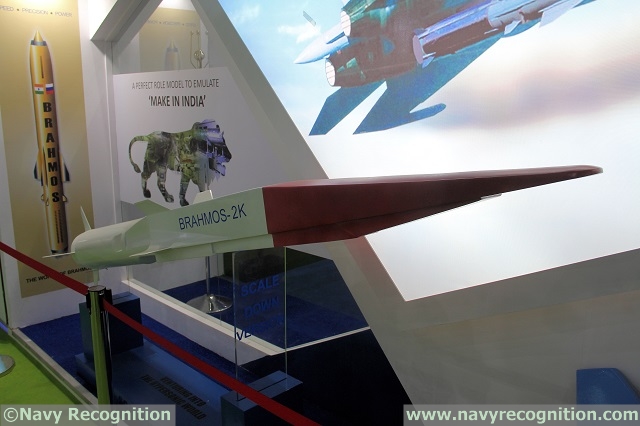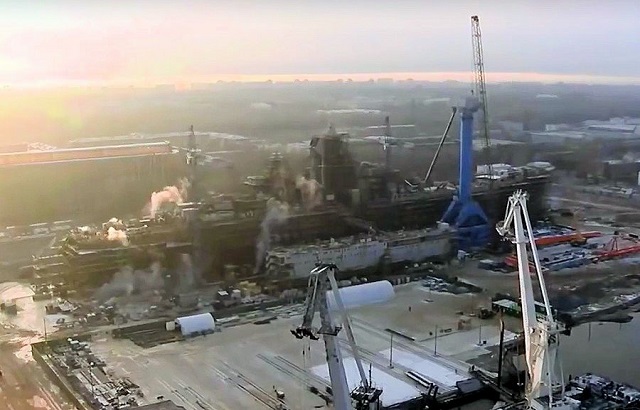 Indo-Russian BrahMos II hypersonic cruise missile scale model on display at DEFEXPO 2016 |
|||
The Sevmash Shipyard launched the modernization of
the Admiral Nakhimov to Project 11442M standard on January 24, 2014. The
modernization started with dismounting the large equipment and systems
subject to replacement or repair. This slashed the structural weight,
which, in turn, made it easier to bring the ship from the berth to the
flooding dock. Pontoons were manufactured by Sevmash for the Admiral Nakhimov
to get across the flooding dock’s caisson gate.
On October 16, 2014, the head of the Severnoye Design Bureau said that the Admiral Nakhimov would remain in service for 30-40 years after the upgrade: "She will be a drastically upgraded ship, almost a brand-new one. She has a good hull, and the rest will be replaced, except the hull and part of the propulsion plant." Sevmash and KBSM (Special Machinebuilding Design Bureau) made a deal for 10 modules of 3S14 vertical launch system (VLS) for installation as part of the cruiser’s upgrade. The deal’s value is estimated at 2.559 billion rubles ($39 million). Thus, 20 SM-225 launchers of the 3K-45 Granit (SS-N-19 Shipwreck) system will be replaced with 10 3S14 VLS modules to accommodate 3M-14 (SS-N-30) land-attack and 3M-54 (SS-N-27A Sizzler) antiship cruise missiles of the Kalibr missile system. The ammunition load will total 80 missiles. |
|||
 Admiral Nakhimov heavy nuclear-powered missile cruiser (TARKR) currently under refit at Sevmash shipyard in Severodvinsk. Picture: Sevmash shipyard via militaryrussia.ru |
|||
The Kalibr is a direct descendant of the Soviet-made 3M-10 Granat (SS-N-21
Sampson) sea-launched cruise missile system - its heavy upgrade, in fact.
Soviet-made nuclear warheads - 200-kiloton TK 66-02s in the first place
- may be easily demothballed and mounted on the advanced missiles. The
TK 66-02 type fitted not only the Granat, but the Kh-55 air-launched and
3M-12 Relief cruise missiles as well (the latter better known as RK-55).
The improved 250-kt TK 66-05 model fitted only the Kh-55SM missile. Both warheads weight 140 kg. Another variant is the lighter - 90-kg - 10-kt TK-60 low-yield warhead developed specifically to equip the 3M55 Oniks (SS-N-26 Strobile) antiship missile. The original Kalibr carries a 500-kg blast-fragmentation warhead. If the conventional warhead is swapped for a nuclear one and the resultant spare internal volume is used rationally, about 400 kg of extra fuel can be carried. This will extend the weapon’s range by another thousand kilometers. To cap it all, the INF Treaty does not cover sea-launched cruise missiles. The characteristics of the 3K22 Tsirkon system’s 3M22 missile remain classified. According to open sources, the cutting-edge missile may have a range of 400 km and its speed will exceed the sonic speed by five to six times. The Pyotr Veliky missile cruiser is scheduled for overhaul in the dock in the third or fourth quarter of 2019, with the overhaul to be complete in late 2022. Ten 3S-14 VLS modules will accommodate all of her missiles. Unlike the US-made Mk 41, the Russian-made VLS will house larger and heavier weapons measuring up to 750 mm in diameter, 9,000 mm in length and 4,000 kg (liquid-fuel missile) or 4,500 kg (solid-propellant one) in weight. This affords considerable range, speed and payload advantages. The designing of the last Soviet missile cruiser (Project 1144) began in the mid-1960s. The lead ship of the five-hull series was laid down by the Baltic Shipyard in Leningrad on March 26, 1974 and was commissioned in 1980. The cruiser was named Kirov. The ships of the class are the world’s largest surface combatants built after WWII, save for aircraft carriers. They displace 24,500 tons, measure 251 m long, have a 140,000-hp nuclear powerplant, a speed of 31 knots and a complement of 728 carry three Kamov Ka-27 (Helix) helicopters. Their main armament is 20 3M-45 Granit antiship missiles with a range of 600 km. The second cruiser in the class, the Frunze, (renamed Admiral Ushakov in 1992) was commissioned in 1984. Both had been in reserve of the Navy for some time. Two other ships - the Admiral Nakhimov and Pyotr Veliky laid down as the Kalinin in 1983 and Yuri Andropov in 1986 - became operational in 1988 and 1998 respectively. The construction of the fifth cruiser was cancelled. © Copyright 2015 TASS. All rights reserved. This material may not be published, broadcast, rewritten or redistributed. |
|||
Russia's Project 11442M Kirov Class Cruiser to be Fitted with 3K22 & 3M22 Tsirkon Hypersonic Missile
- Posted On










